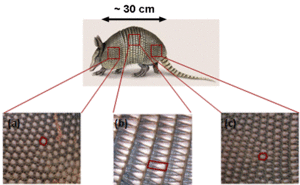Integrated Computational Materials Engineering (ICME)
Armadillo Shell
Abstract
Multiscale hierarchical structures, materials properties, and mechanical behaviors of the nine-banded armadillo (Dasypus novemcinctus) shell were studied to provide fundamental knowledge for understanding biological composite systems. The nine-banded armadillo’s dermal shell is characterized into three regions: the forward, band, and rear shells, with the forward and rear shells comprising a sandwich composite structure. A comparison and contrasting study of the structure-property relations between the armadillo shell and other biological structural materials could provide fundamental understandings for deformation mechanisms that can lead to the development of novel bio-inspired safety system design methodologies.[1]
Introduction

Fig. 1. Typical structure of the nine-banded armadillo’s dermal shells observed in the (a) forward, (b) band, and (c) rear shells.
Like many other armadillos, the nine-banded armadillo is covered by outer
body armor composed of bone with a covering of keratin—plates of dermal bone
covered in relatively small, overlapping epidermal scales called scutes.[2][3][4][5]
In our study, we are exclusively focusing on the structures, materials
properties, and mechanical behavior of the armadillo shell and characterizing
its role for protection. The main objective of the present study is to quantify
the structure-property relationships of the armadillo shell based on the
materials and geometric characteristics.
Structures of differient locations of the nine-banded armadillo shell including
forward, band, and rear shells, as indicated in Fig. 1, were investigated by
using an optical microscope and a scanning electron microscope (SEM). The
outermost keratin layer and various underneath surfaces including the top,
front, side, and bottom planes of the nine-banded armadillo shell were observed
by using an SEM, and their chemical compositions were analyzed by an energy
dispersive x-ray (EDX) spectroscopy technique, respectively.
Mechanical tests in this research included micro-indentation of the dermal
shells using a Vickers hardness tester, and quasi-static compression tests
conducted with an Instron 5882 electromechanical test apparatus.
Results
The forward and rear shells are comprised of a sandwich composite structure of functionally graded material having relatively denser exterior bony layers and an interior bony network of foam layer. The band shell revealed a more complicated structure and adjacent bands in the band shell region are partially overlapped and connected with each other to provide flexibility in addition to protection. Micro-indentation tests and microstructural observations provided that the top and bottom surfaces of the nine-banded armadillo’s dermal shell consist of relatively harder and denser structures. Compression test results on the forward and rear shells showed a typical nonlinear deformation behavior recognizant of synthetic foams, whereas the band shell revealed almost a linear deformation behavior with much smaller fracture strains.
Reference
1. H. Rhee, M.F. Horstemeyer, A. Ramsay, “A study on the structure and
mechanical behavior of the Dasypus novemcinctus shell,” Materials Science and
Engineering: C, Volume 31, Issue 2, 12 March 2011, Pages 363-369, ISSN
0928-4931.
2. C.R. Dickman, in: D.W. Macdonald (Ed.), The New Encyclopedia of Mammals,
Oxford University Press, Oxford, 2001.
3. J.N. Layne, in: G.A. Feldhamer, B.C. Thompson, J.A. Chapman (Ed.), Wild
Mammals of North America: Biology, Management, and Conservation – 2nd Edition,
Johns Hopkins University Press, Baltimore, 2003.
4. D.E. Wilson, S. Ruff, The Smithsonian Book of North American Mammals,
Smithsonian Institution Press, Washington, D.C., 1999.
5. R.W. Kays, D.E. Wilson, Mammals of North America, Princeton University
Press, Princeton, 2002.
